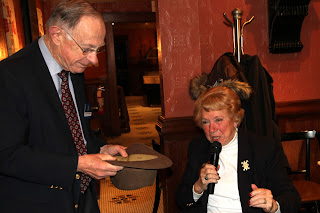Bailey noted that we all agree that The Great Swamp is a tremendous asset to our part of New Jersey. Having a Wildlife Refuge is unique in our metropolitan area. It all started as Lake Passaic 10,000 years ago. At that time, the ridges along Fairmount Ave. and Meyersville Road were islands in the lake, which extended from the Patterson to the beginning of the present Passaic River. When the glacier that produced the lake left the area, a depression which remained became the Great Swamp. Alluvial deposits of clay and sand hold water in the swamp. Early Indians fished along the Passaic River and hunted in the swamp. In the 1600s Dutch settlers bought the swamp from the Indians.
The swamp changed many times over the years. At one time there were huge stands of hardwood. The trees were converted to charcoal which was used at the Speedwell forge to make cannonballs for Washington’s army. Then, the Noe family moved in. They, as well as others, were farmers. The Noe family had 800 acres, 300 in the Great Swamp. After the trees were cut in the swamp, it was a fertile area for farming. There were good drainage ditches between farming plots. You could walk across the “swamp”. Farmers had deer-hunting camps. The land had rolling corn fields. Salt hay was raised to store ice. Farmers planted peach orchards and there was a peach basket factory in Chatham. There was a lumber mill, Zanders mill, in Green Village.
A blight killed the peach trees and that signaled an end to the farming era in the swamp.
At the beginning of the 1900s dairy farming grew and many rose-growing greenhouses were built. Noe dairy was one of two in New Jersey. The greenhouses were the largest along the Eastern Seaboard. Some very wealthy families owned land in the area.
In th late 1900s, the Port Authority of New York studied the Great Swamp as an area to build a Jetport. Most residents were unaware of the early studies. A large amount of land had to be acquired to set up a National Park and block the Jetport construction. An impediment to creating a park was Miele’s Dump, now called the Rolling Knolls Landfill. A group of people were setting up a 50-year lease for 50 towns in the area to truck their waste material into Chatham Township. The garbage trucks ran continuously.
Marcellus Hartley Dodge, Sr. was a key player in the struggle to establish the Great Swamp Wildlife Preserve. He enlisted support from Frelinghuysen and others. He rounded up the funds to acquire the property. He organized wildlife supporters and with support from Congress was able acquire the first 2600 acres. Fred Treptow, a Township Committeeman, was influential in closing down the dump. When the park was first established, it was called a National Wildlife Preserve. It has grown and now the Great Swamp owns about 7,000-8,000 acres.
Today, the result of all this is a far cry from what was originally intended. The wildlife preserve has turned into a wild fowl preserve. The government flooded the land that had previously been mostly dry, except for drainage ditches. All the ditches were dammed up and water level rose. The Great Swamp is now basically wet. Deer and other animals can no longer live there.
Green Village was once an extensive farming community. Now it is too wet. As wetlands have grown, landowners sold their land to the Great Swamp and the property went off the tax rolls.
There is very little return on the investment which has been made in The Great Swamp. The environmental people don’t want to see any development or change in the municipalities surrounding the swamp.
Streams that feed The Great Swamp are closely monitored. The Chatham Township sewage treatment plant dumps their effluent into The Great Swamp. There is now interest in routing it directly to the Passaic River but the cost is tremendous.
Restrictions and regulations due to The Great Swamp are limiting the development of unused land in Chatham Township. It was very important that the Jetport construction was stopped, but that does not mean that there should be no development. A balanced approach is recommended.
Everyone in the audience loudly applauded this interesting and thought-provoking history of the area.














